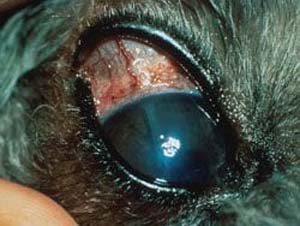Pet Glaucoma Spring, TX
If your pet has been diagnosed with glaucoma, we provide specialized care for this serious eye condition that can cause vision loss in pets.

What is Glaucoma?
Glaucoma is the increase of pressure within the eye or intraocular pressure (IOP). This increase in IOP is a painful condition that will result in blindness if not treated.
What are the clinical signs of glaucoma?
Clinical signs associated with glaucoma include redness, corneal cloudiness, dilation of the pupil, and temporary blindness. Enlargement of the globe and permanent blindness is indicative of chronic glaucoma.
What are the causes of glaucoma?
The most common cause of glaucoma in dogs is genetic. Genetic glaucoma typically develops at 5 to 6 years of age. High-incidence breeds for genetic glaucoma include Cocker Spaniel, Basset Hound, miniature and toy Poodle, Chow Chow, Boston Terrier, Shar Pei, and Shih Tzu. However, any breed, including mixed breeds, can develop genetic glaucoma. If not treated, genetic glaucoma will result in complete blindness, developing in the first eye and affecting the second eye with an average of 8 months. Inflammation within the eye is the second most common cause of glaucoma in dogs and the primary cause in cats. Other etiologies of glaucoma include lens luxation, intraocular tumors, trauma, chronic cataracts, and retinal detachment.
What is the treatment for glaucoma?
Glaucoma is a challenging disease to treat in veterinary medicine. It is essential to lower the intraocular pressure to relieve the pain and preserve vision. Treatment options include medical therapy, surgery, and salvage procedures. The most effective treatment option depends on many factors, including the amount of damage the eye has sustained and the potential for vision. Medical treatment is an important element for treating glaucoma but is not typically effective as a single modality. Employing medical treatment only in early glaucoma is not effective in controlling the IOP over the long term or preserving vision. Surgical treatments, when coupled with medical therapy, have been demonstrated most effective in long-term IOP control and extending vision. Surgical treatments for glaucoma include the application of laser energy to certain portions of the globe to decrease the production of fluid within the eye and the placement of drainage shunts to increase the release of fluid within the eye. Surgery management is usually indicated if vision or the potential of vision is present.
A blind, painful eye that is in the latter stages of glaucoma is usually a candidate for a salvage procedure. These include enucleation (complete removal of the globe) or evisceration, a procedure that is functionally similar to an enucleation but gives the appearance of the globe. As mentioned previously, patients that develop genetic glaucoma in one eye will develop glaucoma in the second eye on an average of 8 months. However, if genetic glaucoma is recognized in the first eye, treating the unaffected eye with once-daily medication has been demonstrated to delay the onset of glaucoma in the second eye for an average of 3 years.
